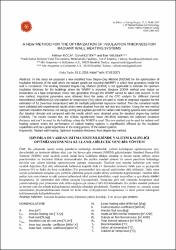A New Method for The Optimization of Insulation Thickness for Radiant Wall Heating Systems
Künye
KOCA, Aliihsan, Gürsel ÇETİN & Eser VELİŞAN. "A New Method for The Optimization of Insulation Thickness for Radiant Wall Heating Systems". Isı Bilimi ve Tekniği Dergisi, 37.2 (2017): 75-88.Özet
In this study we proposed a new modified New Degree-Day Method (NDDM) for the optimization of insulation thickness of the wall where the radiant panels are mounted (WMRP) in which heat generation inside the wall is considered. The existing Standard Degree-Day Method (SDDM) is not applicable to estimate the optimum insulation thickness for the buildings where the WMRP is mounted. Because SDDM method uses indoor air temperature as a base temperature, hence heat generation through the WMRP cannot be taken into account. In the new method, important parameters were obtained from the series of the CFD analysis for different thermal transmittance coefficient (U) and outdoor air temperature (To) values are used to create an empirical equation for the estimation of Tp (new base temperature) with the multiple polynomial regression method. Then the numerical results were validated with experimental results which were obtained from the real-size test chamber. Using the new method optimum insulation thickness, net energy saving and payback periods for radiant wall heating systems were calculated (for Istanbul climate) and compared with the results which were obtained using the standard degree-day method (SDDM). The results showed that, the SDDM significantly lower (85-95%) estimates the optimum insulation thickness and can’t be used for the buildings where the WMRP is used. The new method can be used for radiant wall heating systems where the performance of radiant heating systems is significantly affected by the insulation capabilities and has a great importance in the sizing process of the radiant systems. Bu çalışmada ışınım ısıtma panellerin kullandığı duvarlardaki yalıtım kalınlığının optimizasyonu için, duvarlardaki ısı üretimini dikkate alan, yeni bir derece-gün yöntemi (NDDM) geliştirilmiştir. Standard Derece-Gün Yöntemi (SDDM) temel sıcaklık olarak mahal hava sıcaklığını dikkate almakta ve duvara monte edilmiş ışınım panellerindeki ısı üretimini dikkate alamamaktadır. Bu yüzden standart yöntem ile ışınım panellerin bulundugu duvarlar için yalıtım kalınlığı optimizasyonu yapmak imkansızdır. Önerilen yeni metotta kullanılan yeni temel sıcaklık değerinin (Tp) elde edilmesinde kullanılan ampirik ifade (3. dereceden polinom) farklı yapı ısı geçirgenlik katsayısı (U) ve farklı dış hava sıcaklıkları (To) parametreleri için sayısal analizlerden elde edilmiştir. Daha sonra sayısal çalısmaların sonuçları aynı şartlarda yürütülen gerçek ölçekli deney sisteminde doğrulanmıştır. İstanbul iklim şartları için yeni yöntem ve eski yontem kullanılarak ideal yalıtım kalınlıkları, enerji tasarrufları ve geri dönüş süreleri hesaplanmış, iki yöntemden elde edilen sonuçlar kıyaslanmiştir. Sonuçlara göre eski yöntemle hesaplanan ideal yalıtım kalınlığı yeni yöntemden elde edilen değerin çok altında (%85-95) kalmaktadır. Bu yüzden standart yöntemin ısı üretimi olan duvarlarda kullanılmasının mümkün olmadığı görulmüştür. Önerilen yeni yöntem ise, ışınımla ısıtma sistemlerinin projelendirilmesinde önemli bir kriter olan ısı kayıplarının hesaplanması ve ideal yalıtım kalınlığının belirlenmesinde kullanılabilecektir.



















